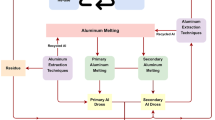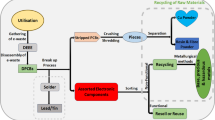Abstract
Cu impurities in scrap, originating from motors and wires, limit the efficiency of recycling steel scrap, especially for shredded automobile scrap, due to the occurrence of surface hot shortness during hot working resulting from high Cu content. Considering the distinct difference of color between metal Cu and Fe and the potential differences between shapes of shreds depending on Cu content, optical recognition was explored as a method for detecting and separating Cu-rich shreds. In order to optimize detection and minimize effects of surface inhomogeneity, etc., convolutional neural networks (CNNs) were adopted to improve the optical recognition of shredded scrap obtained from industrial sources. The results show that the proposed neural network achieves significantly better recognition on Cu impurities and results in a reduction of Cu content. An optimized accuracy of 90.6% could be obtained for recognizing Cu impurities through applied CNNs architecture with dataset of cropped photographs. This results in an overall reduction of Cu impurities from 0.272 to 0.087 wt% in steel scrap, if the identified Cu-rich parts were removed.
Graphical Abstract













Similar content being viewed by others
References
Graedel T et al (2011) What do we know about metal recycling rates? J Ind Ecol 15:355–366
Huellen M et al (2006) EAF-based flat-steel production applying secondary metallurgical processes. Secondary steelmaking session–Paper 7.1. https://www.researchgate.net/profile/Zulfiadi_Zulhan/publication/257927955_EAF-Based_Flat-Steel_Production_Applying_Secondary_Metallurgical_Processes/links/0c9605263698093b2c000000.pdf
Kerimov RI, Shakhov SI (2020) Use of metallized raw materials in electric furnace steelmaking. Metallurgist. https://doi.org/10.1007/s11015-020-00974-1
ASM Handbook Committee (1970) Metals Handbook, Vol 5, Forging and Casting. American Society for Metals, Metals Park, Ohio, p. 72
LeMay Iain, Schetky LM (1982) Copper in iron and steel. Wiley
Madias J (2014) Electric furnace steelmaking. Treatise on process metallurgy. Elsevier, Amsterdam, pp 271–300
Daehn KE, Serrenho AC, Allwood JM (2017) How will copper contamination constrain future global steel recycling. Environ Sci Technol 51:6599–6606
Latad SK et al (2019) Automatic object sorting machine. Int Res J Eng Technol 06(04):3259–3264
Knapp H et al (2014) Viable applications of sensor-based sorting for the processing of mineral resources. ChemBioEng Rev 1(3):86–95
Pearson T (2010) High-speed sorting of grains by color and surface texture. Appl Eng Agric 26(3):499–505
Ibrahim UM et al (2019) Design and implementation of a plastic waste sorting system. In: 2019 15th international conference on electronics, computer and computation (ICECCO). IEEE
Kashiwakura S, Wagatsuma K (2013) Characteristics of the calibration curves of copper for the rapid sorting of steel scrap by means of laser-induces breakdown spectroscopy under air atmosphers. Anal Sci 29:1159–1164
Mesina MB, De Jong TPR, Dalmijn WL (2007) Automatic sorting of scrap metals with a combined electromagnetic and dual energy X-ray transmission sensor. Int J Miner Process 82(4):222–232
Buzanich G (2016) A newly developed XRF-sensor with high sensitivity for increasing sorting efficiency, 7th Sensor-Based Sorting Control, 221–232. https://www.lla-instruments.com/files/lla/images/bilder/Einsatzbereiche/XRF/A newly developed XRF-Sensor.pdf
Shulman AD (2008) Method for bulk sorting shredded scrap metal, U.S. Patent No. 7,886,915
Sato S, Takeuchi M, Mizukami Y, Birat JP (1995) The Shinseiko Project: a new environment friendly steelmaking route based on scrap. ATS Int Steelmaking Conf Session 1:473–483
Vailaya A, Figueiredo MAT, Jain AK, Zhang H-J (2001) Image classification for content-based indexing. IEEE Trans Image Process 10(1):117–130
Guo Y et al (2016) Deep learning for visual understanding: a review. Neurocomputing 187:27–48
Hassan M (2019) VGG16: convolutional network for classification and detection. https://neurohive.io/en/popular-networks/vgg16/
Wang D et al (2017) Modulation format recognition and OSNR estimation using CNN-based deep learning. IEEE Photonics Technol Lett 29(19):1667–1670
Rangarajan Aravind K, Raja P (2020) Automated disease classification in (Selected) agricultural crops using transfer learning. Automatika 61(2):260–272
Rosebrock A (2017) Imagenet: vggnet, resnet, inception, and xception with keras. https://www.pyimagesearch.com/2017/03/20/imagenet-vggnet-resnet-inception-xception-keras/
Rosebrock A (2018) Keras and convolutional neural networks (CNNs). https://www.pyimagesearch.com/2018/04/16/keras-and-convolutional-neural-networks-cnns/
Chollet F (2017) Xception: deep learning with depthwise separable convolutions. In: Proceedings of the IEEE conference on computer vision and pattern recognition
Kumar P (2003) Metal scrap sorting system. U.S. Patent No. 6,545,240
Huellen M et al (2006) EAF-based flat-steel production applying secondary metallurgical processes. In: Ironmaking Steelmaking Conference, Linz, Austria
Fruehan RJ et al (2000) Theoretical minimum energies to produce steel for selected conditions. Carnegie Mellon University, Pittsburgh
Wei TC, Sheikh UU, Ab Rahman AA (2018) Improved optical character recognition with deep neural network. 2018 IEEE 14th International colloquium on signal processing & its applications (CSPA). IEEE, Piscataway
Acknowledgement
This material is based upon work supported by the U.S. Department of Energy’s Office of Energy Efficiency and Renewable Energy (EERE) under the Advanced Manufacturing Office Award Number DE-EE0007897.
Author information
Authors and Affiliations
Corresponding author
Ethics declarations
Conflict of interest
On behalf of all authors, the corresponding author states that there is no conflict of interest.
Additional information
The contributing editor for this article was Sharif Jahanshahi.
Publisher's Note
Springer Nature remains neutral with regard to jurisdictional claims in published maps and institutional affiliations.
Rights and permissions
About this article
Cite this article
Gao, Z., Sridhar, S., Spiller, D.E. et al. Applying Improved Optical Recognition with Machine Learning on Sorting Cu Impurities in Steel Scrap. J. Sustain. Metall. 6, 785–795 (2020). https://doi.org/10.1007/s40831-020-00300-8
Received:
Accepted:
Published:
Issue Date:
DOI: https://doi.org/10.1007/s40831-020-00300-8




